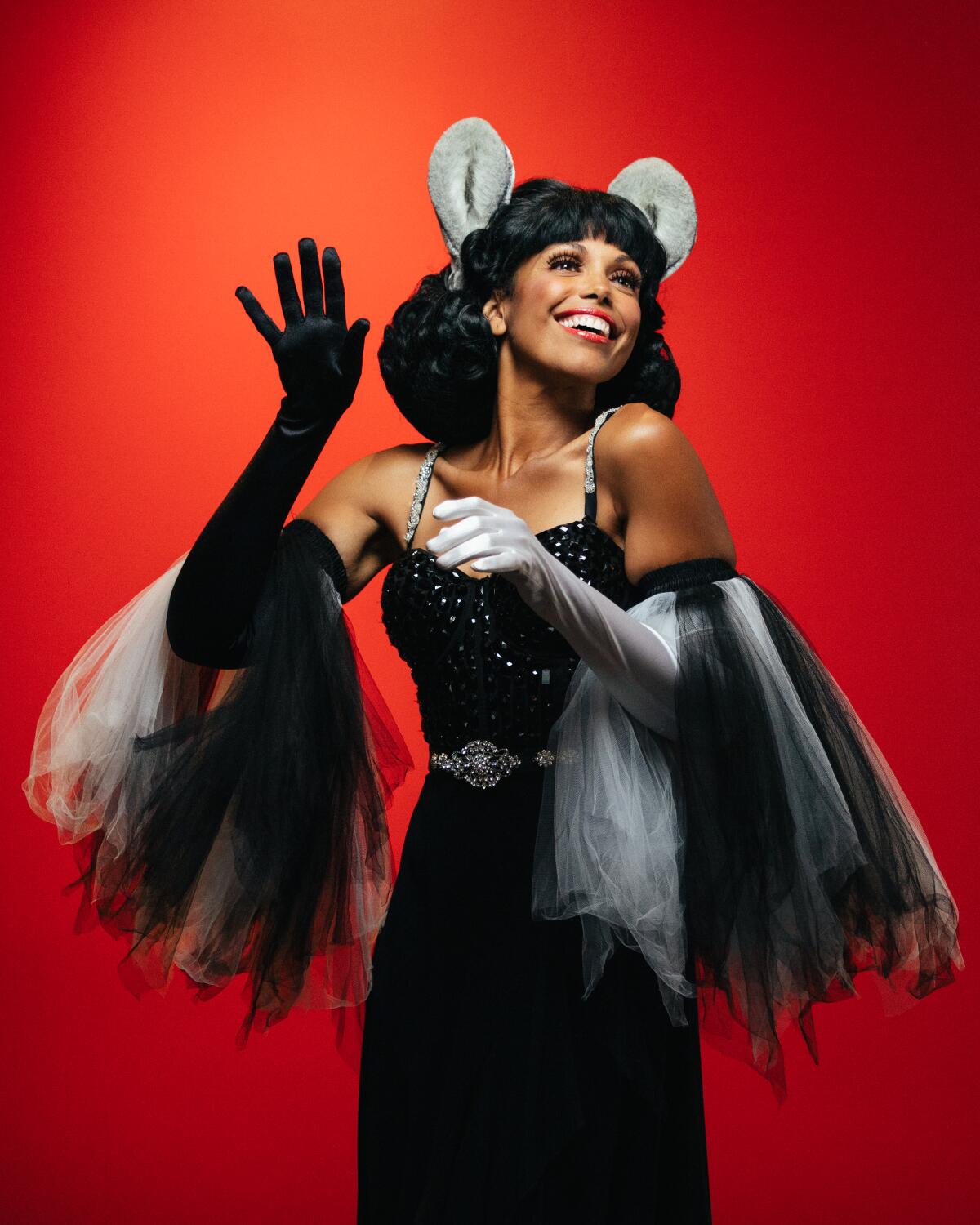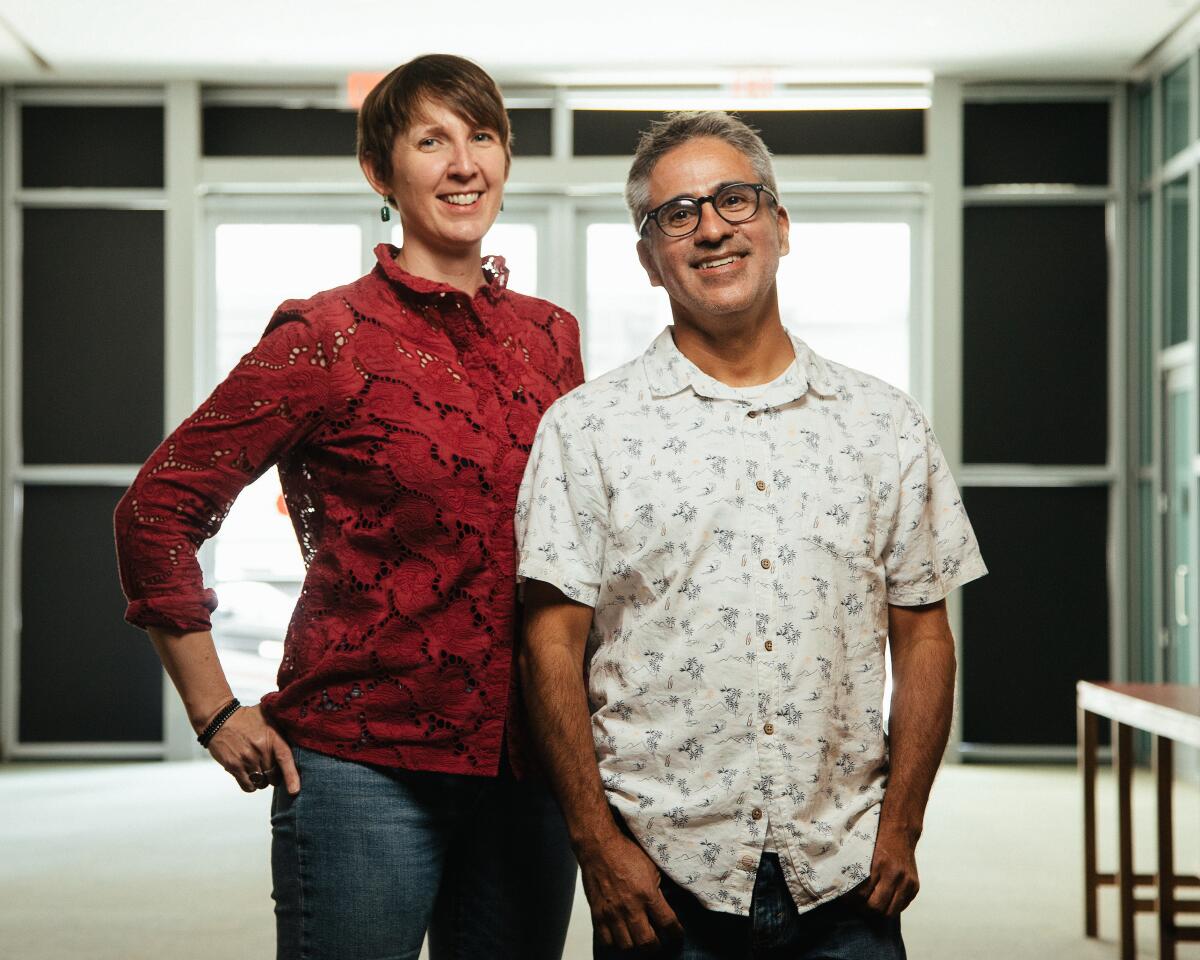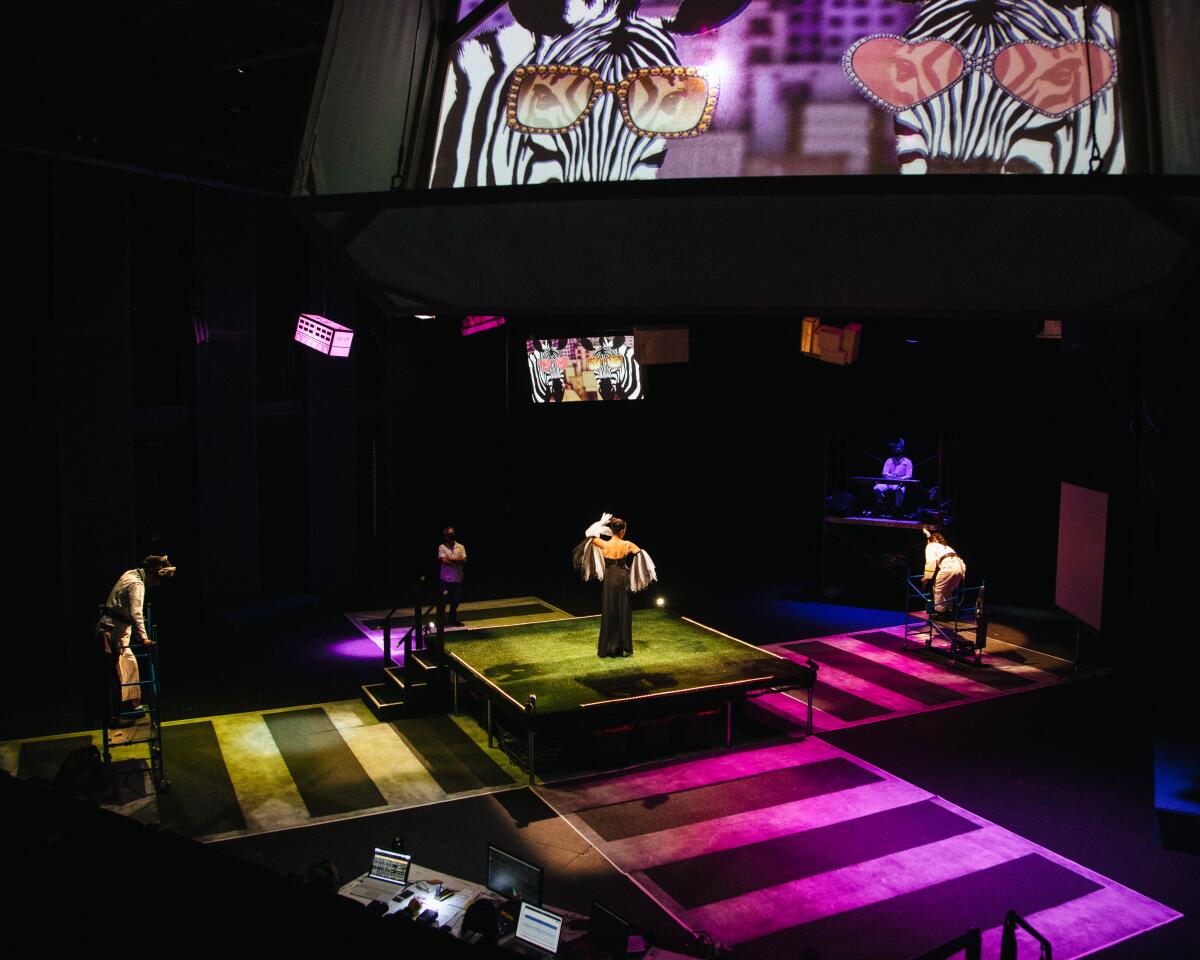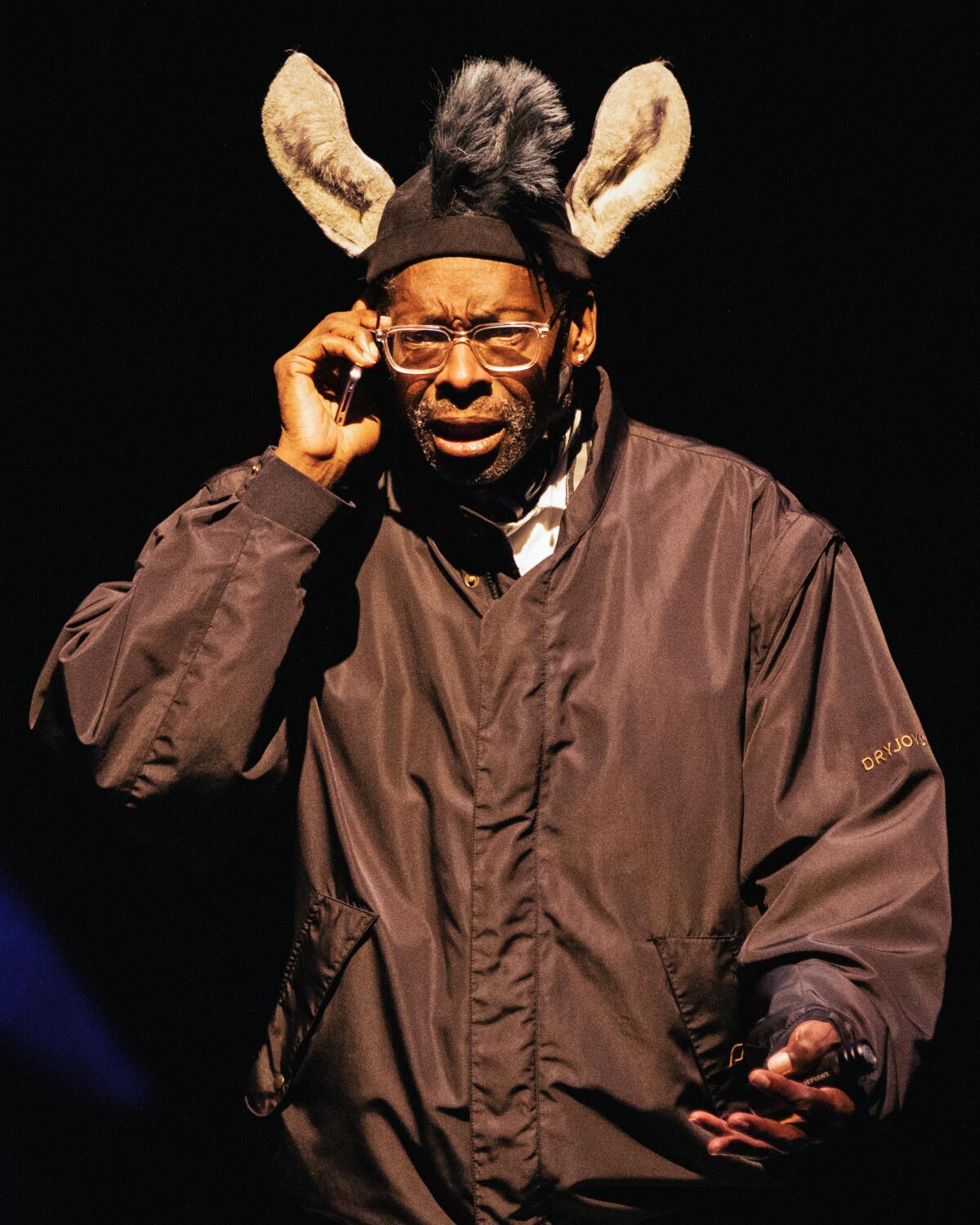The biggest entertainment stories
Get our big stories about Hollywood, film, television, music, arts, culture and more right in your inbox as soon as they publish.
You may occasionally receive promotional content from the Los Angeles Times.

“If we can get used to seeing people living in tents, and that being the norm, then we can also get used to the idea that everyone can be housed,” says actress Karla Mosley about the premise behind the new immersive performance piece she stars in called “The Most Beautiful Home … Maybe,” playing at REDCAT through Saturday.
Mosley is perhaps best known for the role of Maya Avant Forrester on “The Bold and the Beautiful,” but she has devoted much of her career to social justice and activism, which is why she wound up fronting an experimental show that seeks to coalesce public awareness around America’s housing crisis. She accomplishes this by playing a chanteuse zebra in a dazzle of zebras.
Created by Mark Valdez and Ashley Sparks, and produced by Mixed Blood Theatre in Minneapolis, “The Most Beautiful Home … Maybe,” uses time travel, statistics, policy-wonk factoids, audience participation, torch songs, interactive games and conversation to brainstorm workable solutions to one of our nation’s most pressing, entrenched problems.
After the show plays at REDCAT, it will travel to partner cities including Syracuse, N.Y., St. Paul, Minn., and Mesa, Ariz. On May 21, before the final L.A. show, the group has teamed with the Japanese American Cultural and Community Center and Sustainable Little Tokyo for a daylong housing symposium called “Housewarming: Little Tokyo & Skid Row,” which includes a walk-through of both areas.
Valdez and Sparks have spent their careers working at the intersection of the arts, theater, cultural organization, community engagement and consulting — and are uniquely poised to use performance practice in service of effecting social, cultural and political change.

Valdez says the idea for the show came to him during a dark period of the Trump presidency when he felt the turbulent issues facing America were piling up with alarming speed. As an artist he felt a particular urgency — like he no longer had the luxury of time to change hearts and minds. So he decided to create a show that would put his audience on the front lines of housing policy.
“I wanted to invite them into a process with the hope and belief that they will change — and if they can change, then maybe our policy and practices can change,” Valdez says.
To build the script, Valdez and Sparks held a series of workshops in various locales across the country and invited advocates, activists, policymakers, developers and government officials to participate. The goal was to discuss and formulate innovative solutions to problems of homelessness, affordable housing, the housing shortage, NIMBYism and more.
Valdez recalls a personal turning point during a workshop when someone asked one of the group’s housing partners, “What is the biggest challenge that you face in your work?” Their answer wasn’t a lack of support or money but rather “a lack of imagination.”
“That was the moment where it was like, ‘Great, we can do this,’ because we can do something about imagination, we know how to do that,” Valdez says.
Discussions around housing policy, say Valdez and Sparks, are often constrained by the fear that a particular policy won’t pass political muster — and getting bills passed is the name of the game in policy. So the thinking around chronic issues like housing becomes smaller and smaller as the problem itself grows bigger and bigger.
“We need a gigantic imaginary leap so that we can start to address the problems that we’re facing,” Valdez says.

Part of that leap involves simply speaking certain ideas in a public forum, he says. Words that might get a person laughed out of a policy meeting are welcomed in “The Most Beautiful Home … Maybe.”
“What does it look like when everybody is housed?” is a question the show asks out loud. It then seeks to paint a picture of that possible reality with the hope that if people can start envisioning such a thing, they can also make their way toward it.
Sparks says the idea of universal housing didn’t always seem so radical. She was greatly moved by reading a speech given by Lyndon B. Johnson after he signed the Housing and Urban Development Act in 1965.
“We must make sure that every family in America lives in a home of dignity and a neighborhood of pride, a community of opportunity and a city of promise and hope,” Johnson said.
If that had happened, Sparks wonders, how different would our communities look? If everyone had access to affordable housing, senior citizens were not displaced and people living paycheck to paycheck weren’t worried about keeping the shelter over their heads?
Our country would actually just be healthier and more prosperous if there was housing stability, she says.
“I can feel my body get lighter when I imagine that world,” Sparks says, “where people are not living in the fear and stress of being unhoused or losing their home, or worried about where they’re going to live when they’re old.”
Sparks has spent years in the weeds of what she calls “very technical housing policy” through working with various advocacy organizations including the Natural Resources Defense Council and the National Housing Trust. She is also, she says, “a theater dork.”
“The skills that you have as a theater artist are actually superpowers for solving community problems and creating spaces for people to have hard conversations,” Sparks says.
Concepts introduced to audiences by Mosley for examination include excising the idea of owning a single-family home from the American dream.

Housing can be communal and multigenerational, says Mosley.
“We can reimagine what our neighborhoods can look like and what a neighborhood is,” she says.
Valdez is particularly animated about this idea, saying, “What would we create? What kind of high density, co-op driven models of housing could we could create? How do we build the additional 68 million homes that we need? How do we incentivize mom-and-pop landlords to keep their units affordable?”
The housing crisis in America is not new, but in the wake of the pandemic, millions of middle-class Americans are now experiencing housing instability in the face of rapidly ballooning rent and real estate prices. A recent survey by the Public Policy Institute of California found that nearly 55% of Californians were concerned about not having enough money to pay their rents or mortgages.
It is a problem for everyone, coast to coast, and it requires solutions for everyone.
Perhaps the best place to start, says the team behind “The Most Beautiful Home … Maybe,” is to ask yourself a single question: “What if everyone in this country had a home?”
'The Most Beautiful Home ... Maybe'
Where: REDCAT in the Walt Disney Concert Hall Complex, 631 W. 2nd St., L.A.
When: 8:30 p.m. Thursday, 4 and 8:30 p.m. Friday, 8:30 p.m. Saturday with a simultaneous virtual show.
Tickets: $13-$25
Running time: 90 minutes, no intermission
Info: redcat.org, (213) 237-2800
COVID protocol: Proof of full vaccination is required, including booster if eligible. Masks are required at all times. (Check website for changes.)
The biggest entertainment stories
Get our big stories about Hollywood, film, television, music, arts, culture and more right in your inbox as soon as they publish.
You may occasionally receive promotional content from the Los Angeles Times.